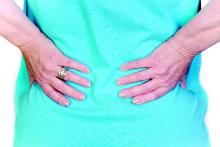AMSTERDAM – Data from a longitudinal study reported at the World Congress on Osteoarthritis show that weight gain in young women is an independent predictor of future low back pain.
Indeed, for every 5 kg in weight gained, the risk for low back pain in the coming decade was increased by 5%, after researchers accounted for women’s age, height, physical activity, education level, and mental health (depressive status).
“Low back pain is the greatest contributor to disability worldwide,” said the presenting author Dr. YuanYuan Wang of Monash University, in Melbourne. “Since treatment options have limited efficacy, understanding the role of lifestyle factors will be very important for prevention,” she said at the meeting, which was sponsored by Osteoarthritis Research Society International.
Dr. Wang noted that prior studies had looked at the relationship between obesity and physical activity, and back pain, but that there were inconsistent findings and a lack of longitudinal data. Few studies had been done on younger populations of adults, and there was evidence that previous episodes of back pain can predict further recurrence. So the team at Monash University decided to look further at the issue by taking data from the Australian Longitudinal Study on Women’s Health. They obtained information on women born between 1973 and 1978 who had completed health surveys every 3 years between 2000 and 2012.
Of more than 9,000 women included, 3,688 had low back pain and 5,417 did not at the start of the study, for a baseline low back pain prevalence of 41%. Women with low back pain at baseline were slightly older than those without (24.6 vs. 24.5; P = .008) and more likely to be heavier, with mean weights of 66 kg and 65 kg, respectively (P less than .001). Women with low back pain at baseline were more likely to have depression (14.2% vs. 10.2%; P less than .001), be less physically active (P = .022), and not in paid work (P less than .001). Only 38% of those with low back pain had sought help.
Over the 12-year study period, the prevalence of low back pain increased from 41% to 50% by the fourth follow-up, and the predictors for having any back pain over the course of the 12 years were increasing age, with an adjusted odds ratio of 1.15 for every 5 additional years; weight (OR, 1.05); inadequate physical activity (OR, 1.14); and depression (OR, 1.17).
Similar results were seen when a time-lag statistical model was used to predict the likelihood of low back pain within the next 3 years.
“Increasing weight, decreasing physical activity, and depression are independent predictors of back pain over the following decade,” Dr. Wang reported. The adverse effects of weight on back pain were not affected by the level of physical activity, with similar OR for weight leading to back pain regardless of how active the participants were.
There are limitations to these data, notably that both weight and back pain were self-reported, Dr. Wang said. Nevertheless, the findings show that low back pain is prevalent in this community-based sample of young women and that targeting weight gain through diet rather than physical exercise may be important.
In another study, Dr. Wang and her associates looked at the relationship between physical activity and back pain in a different community-based sample, using television viewing as a marker of sedentary behavior. Dr. Wang’s colleague, Dr. Sultana Hussain, also of Monash University, presented the findings from a prospective study of more than 5,000 men and women in the Australian Diabetes and Lifestyle Study (AusDiab).
Of the 11,247 participants in AusDiab, just over 6,000 were contacted and asked to complete a chronic back pain questionnaire between 2013 and 2014, and roughly 80% responded. Data on respondents’ physical activity level, amount of TV viewing, and demographics that had been collected within AusDiab between 1999 and 2000 also were obtained.
The 2,197 men and 2,777 women, aged 46-51 years, who responded to the chronic back pain questionnaire were divided into groups based on the presence and intensity of their back pain, with 63.3% of men and 60.6% of women reporting low-intensity back pain and 18.1% and 21.5%, respectively, reporting high-intensity back pain. The number of physical activity hours per week was around 6 hours for men and 4 hours for women, and the number of hours of TV watched was similar for each at 1.5-2.0 per day.
The team also looked at back pain disability and found that although three-quarters of men and about 72% of women had no disability, about 15% of men and women had a low level of disability, and 10%-13% had a high level of disability.

